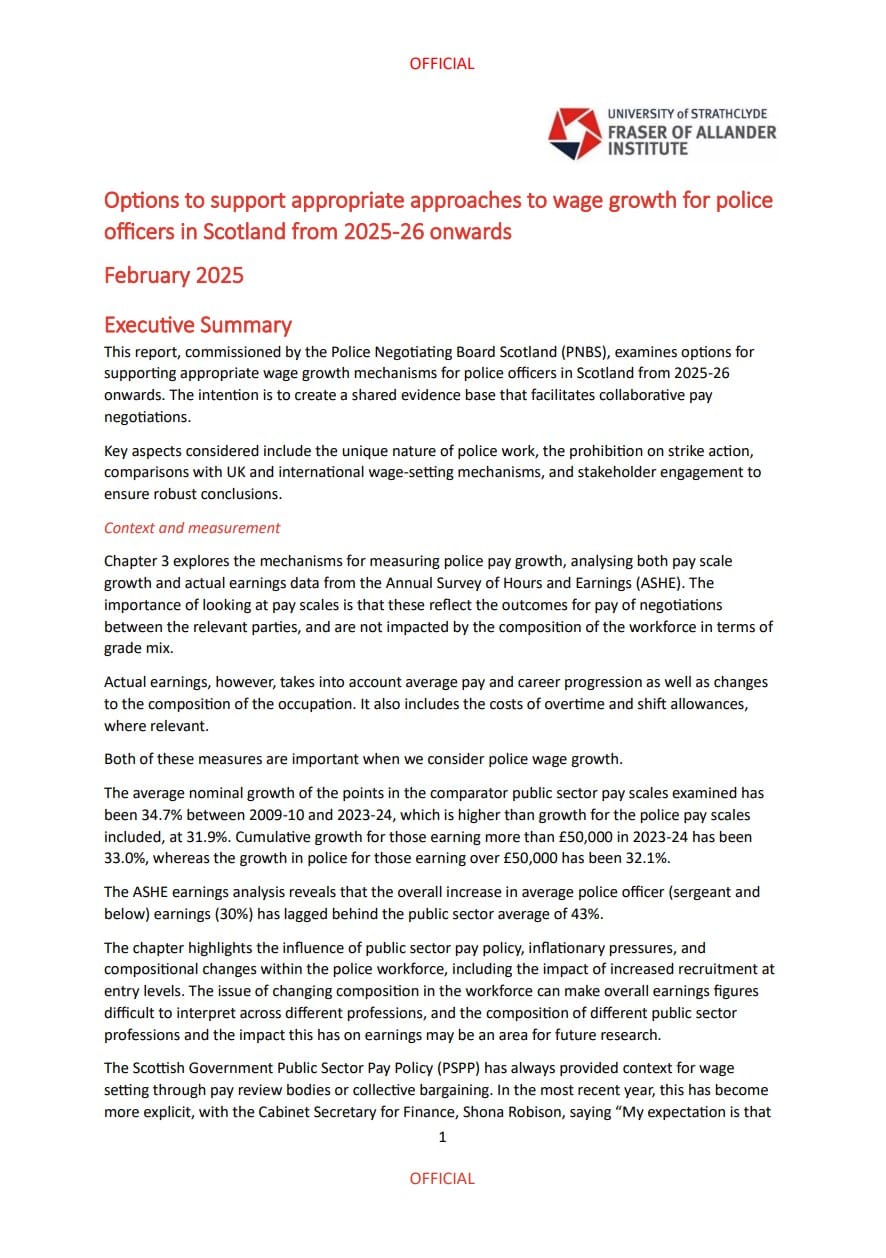This report, commissioned by the Police Negotiating Board Scotland (PNBS), examines options for supporting appropriate wage growth mechanisms for police officers in Scotland from 2025-26 onwards. The intention is to create a shared evidence base that facilitates collaborative pay negotiations.
Key aspects considered include the unique nature of police work, the prohibition on strike action, comparisons with UK and international wage-setting mechanisms, and stakeholder engagement to ensure robust conclusions.
Context and measurement
Chapter 3 explores the mechanisms for measuring police pay growth, analysing both pay scale growth and actual earnings data from the Annual Survey of Hours and Earnings (ASHE). The importance of looking at pay scales is that these reflect the outcomes for pay of negotiations between the relevant parties, and are not impacted by the composition of the workforce in terms of grade mix.
Actual earnings, however, takes into account average pay and career progression as well as changes to the composition of the occupation. It also includes the costs of overtime and shift allowances, where relevant.
Both of these measures are important when we consider police wage growth.
The average nominal growth of the points in the comparator public sector pay scales examined has been 34.7% between 2009-10 and 2023-24, which is higher than growth for the police pay scales included, at 31.9%. Cumulative growth for those earning more than £50,000 in 2023-24 has been 33.0%, whereas the growth in police for those earning over £50,000 has been 32.1%.
The ASHE earnings analysis reveals that the overall increase in average police officer (sergeant and below) earnings (30%) has lagged behind the public sector average of 43%.
The chapter highlights the influence of public sector pay policy, inflationary pressures, and compositional changes within the police workforce, including the impact of increased recruitment at entry levels. The issue of changing composition in the workforce can make overall earnings figures difficult to interpret across different professions, and the composition of different public sector professions and the impact this has on earnings may be an area for future research.
The Scottish Government Public Sector Pay Policy (PSPP) has always provided context for wage setting through pay review bodies or collective bargaining. In the most recent year, this has become more explicit, with the Cabinet Secretary for Finance, Shona Robison, saying “My expectation is that all public sector employers will negotiate multi-year deals with trade unions and staff representatives within the parameters set out in this policy.”
The rest of the report examines three options for wage setting: collective bargaining, pay review bodies, and index-linked pay.
Collective Bargaining
Chapter 4 assesses collective bargaining as a wage-setting mechanism. Used widely across public sector occupations in Scotland, collective bargaining allows unions to negotiate directly with employers on pay and conditions. For police officers, this mechanism has delivered nominal pay growth aligned with public sector norms but has struggled to fully address inflation’s impact.
Benefits of collective bargaining include structured negotiations, inclusivity, and the ability to consider non-pay benefits like workplace conditions. However, challenges include increased costs, the potential for industrial disputes, and limited responsiveness to sudden economic changes. Globally, collective bargaining is the preferred model for public sector pay-setting, though arbitration is often used to resolve impasses.
Pay Review Bodies
Chapter 5 examines the role of independent pay review bodies, such as the Police Remuneration Review Body (PRRB) in England and Wales. These bodies provide impartial recommendations on pay adjustments based on economic conditions, recruitment challenges, and affordability constraints. While their independence enhances transparency and trust, their recommendations are non-binding, leaving governments with the ultimate authority.
Evidence shows pay review bodies often deliver modest outcomes constrained by government spending limits. Internationally, similar bodies exist but are less common than collective bargaining frameworks. The chapter highlights the trade-off between independence and reduced control for direct negotiations by affected parties.
Index Linked Pay
Chapter 6 evaluates index-linked pay, where wage increases are tied to macroeconomic indicators like inflation or average earnings. Historical modelling suggests that had police pay in Scotland been linked to Consumer Price Inflation (CPI) since 2010, officers’ earnings could have been £3,500-£4,500 higher in 2023. This is not unique to the police, however. It is generally true across the board for all but a few exceptions in terms of public sector jobs, and certainly the case for most positions with levels of pay comparable to that of police officers.
Indexation offers predictability and fairness, reflecting real-time economic conditions. However, it reduces flexibility and risks over- or under-compensating employees during volatile economic periods. Examples from countries like Belgium, where wages are indexed to inflation, demonstrate potential benefits but also highlight fiscal challenges during high-inflation periods.
Conclusion
In conclusion, the report underscores the complexity of designing a wage-setting mechanism that balances fairness, affordability, and operational sustainability. Collective bargaining offers inclusivity but lacks agility; pay review bodies enhance transparency but are constrained by affordability remits; and index-linked pay provides predictability but limits flexibility.
Therefore, different approaches to wage setting can have their benefits and limitations, and all approaches have potential merits that both workers and employers in sectors may find attractive.
The reasons for different approaches in different sectors can be historical, cultural and of course legislative, if particular routes are blocked by law to employees in particular occupations.
What this report demonstrates is that there is not necessarily an optimal approach that can be identified through analysis of the outcomes in terms of pay scales and wage growth. Many factors can influence the outcomes on pay, including the overall fiscal stance of the UK Government, and the Public Sector Pay Policy that is set by the Scottish Government, which can provide the context and parameters for any discussions on pay, whichever mechanism is used.
Authors
João is Deputy Director and Senior Knowledge Exchange Fellow at the Fraser of Allander Institute. Previously, he was a Senior Fiscal Analyst at the Office for Budget Responsibility, where he led on analysis of long-term sustainability of the UK's public finances and on the effect of economic developments and fiscal policy on the UK's medium-term outlook.
Ben is an Economist Fellow at the Fraser of Allander Institute working across a number of projects areas. He has a Masters in Economics from the University of Edinburgh, and a degree in Economics from the University of Strathclyde.
His main areas of focus are economic policy, social care and criminal justice in Scotland. Ben also co-edits the quarter Economic Commentary and has experience in business survey design and dissemination.
Mairi is the Director of the Fraser of Allander Institute. Previously, she was the Deputy Chief Executive of the Scottish Fiscal Commission and the Head of National Accounts at the Scottish Government and has over a decade of experience working in different areas of statistics and analysis.



